Table Of Contents
Table of Contents
Should I put butter under the skin of my turkey? This question intrigues home cooks and holiday chefs alike, as many wonder whether this culinary trick truly enhances flavor and texture or if it’s simply a myth. For those planning the perfect holiday centerpiece, achieving a balance between juicy meat and crispy, golden skin can be challenging.
In this article, we dive into the benefits and potential drawbacks of buttering your turkey under the skin. We’ll explore flavor enhancements, healthier alternatives, and expert techniques to help you decide if this method is right for your next roast turkey. Let’s uncover whether butter under the skin makes a difference and elevate your holiday feast to the next level.
The Tradition of Buttering Turkey
History of Butter in Turkey Preparation
The tradition of putting butter in turkey goes back to traditional European cooking techniques, in which fat was used to retain moisture while roasting. Butter was coveted not just because of its flavor, but also for its capacity to enhance texture and texture, which is why it was a common ingredient in Thanksgiving recipes.
Over time, chefs began placing butter directly under the skin to boost flavor absorption and achieve a fresher, crisper finish. This evolution in technique naturally leads many modern cooks to wonder, “Should I put butter under the skin of my turkey?”—a question that connects time-honored practices with today’s culinary innovations.
Why Butter is Popular for Roasting Turkey
The ability of butter to melt and absorb into the meat aids in maintaining its tenderness and flavor. It also provides a rich taste that pairs well with spices and herbs. This technique enhances the flavor without the need for constant basting, which is ideal for those looking for a quick cooking method that doesn’t compromise quality.
Benefits of Putting Butter Under the Skin
Improving Flavor and Moisture
One of the main benefits of applying butter under the skin lies in its capability to provide water directly into the meat. While the butter melts cooking, it engorges the turkey with rich, delicious juices that ensure it remains tender and delicious.
Benefits of key importance are:
- More Flavor Butter can be mixed with garlic, herbs, and spices, resulting in layers of flavor across the entire bird.
- Moisture Retention The product prevents the Breast meats from drying, making sure that every piece is moist.
- enhanced texture Butter melts slowly, which allows an even distribution of moisture.
Achieving Crispy, Golden Skin
Butter plays an important part in forming a crisp skin. The fat content is high, which assists in letting the skin brown evenly giving it the perfect golden look we desire. When combined with spices butter provides a glossy shine that enhances its visual appeal and enhances the taste.
How to Properly Put Butter Under the Skin
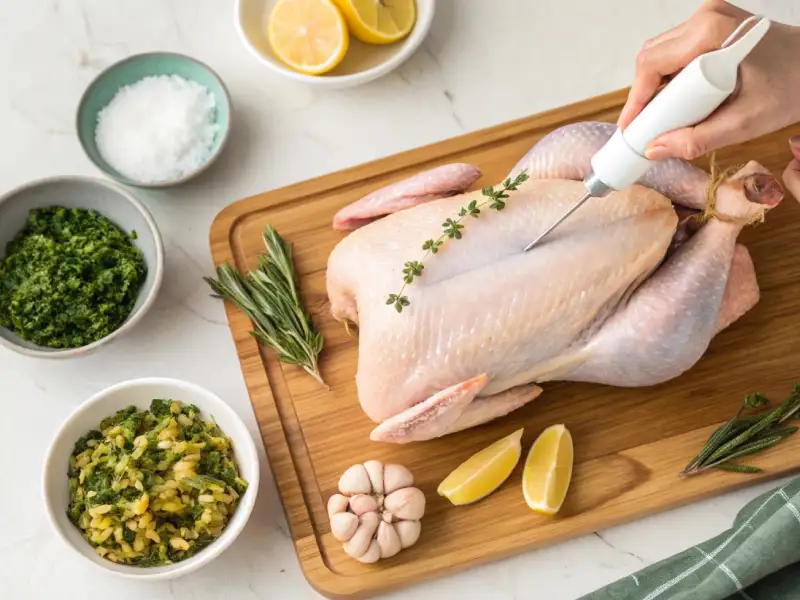
Step-by-Step Guide
- Prepare the Turkey: Pat the turkey dry with paper towels to remove excess moisture.
- Loosen the Skin: Gently slide your fingers between the skin and the meat, starting at the neck and working your way down. Be careful not to tear the skin.
- Season the Butter: Mix softened butter with herbs, garlic, lemon zest, salt, and pepper for added flavor.
- Apply the Butter: Spread the butter evenly under the skin, focusing on the breast and thigh areas. Use about 1/2 cup of butter for a medium-sized turkey.
- Smooth the Skin: Press the skin back into place and rub any remaining butter on the outside for extra crispiness.
Tips for Effective Application
- Chill the Butter: Slightly firm butter is easier to handle and less likely to melt prematurely.
- Use a Spoon or Piping Bag: These tools can help distribute butter evenly without creating a mess.
- Don’t Forget the Cavity: Add aromatics like onions, garlic, and herbs inside the turkey for an extra flavor boost.
Alternative Ingredients for Moist and Flavorful Turkey
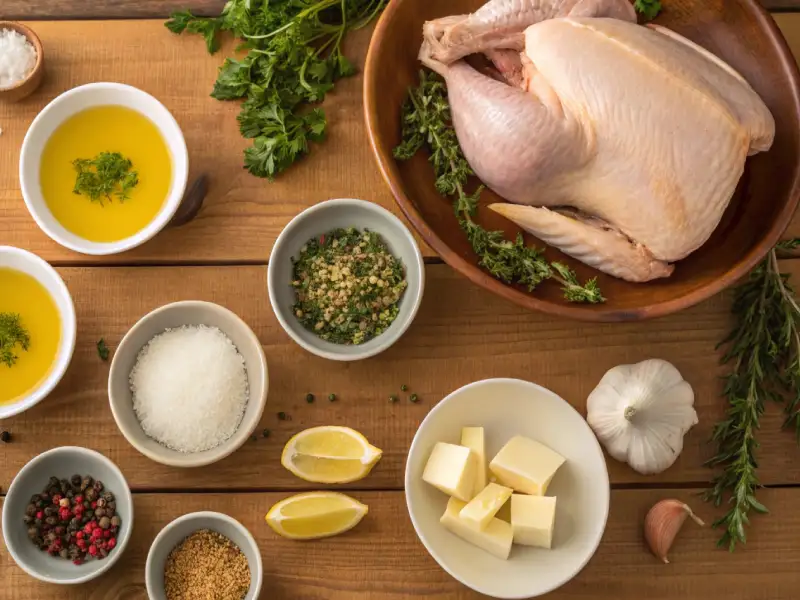
Herb-Infused Oils
If you’re seeking a healthier or dairy-free alternative the herb-infused oils are an excellent option to replace butter. Avocado oil, olive oil along with grapeseed oil, are great alternatives due to their high smoke point and delicious flavors.
To find out more about the question of whether butter or oil is more suitable to roast turkey It is possible to be able to find this thorough comparison of roasting methods useful. It examines how both perform under heat and also their effects on texture and flavor.
Why Choose Oils Over Butter?
- health benefits Oils are abundant in heart-healthy fats. Particularly monounsaturated fats that can reduce cholesterol levels.
- Better absorption of flavors Infused oils can carry spices and herbs effectively to ensure flavor penetration into the meat.
- Easy to Use The oil is easier to distribute and will not harden when handled.
How to Make Herb-Infused Oil:
- Heat 1/2 cup of oil over low heating.
- Include fresh herbs such as rosemary, thyme, or sage. Add the zest of a lemon and garlic cloves.
- Let it sit for about 10 minutes. Cool before applying it to the skin of the turkey.
Compound Butter Recipes
For those who still want the rich flavor of butter but with a gourmet twist, compound butter are an excellent upgrade.
Popular Combinations:
- Garlic and Herb Butter: Minced garlic, parsley, thyme, and rosemary.
- Citrus Butter: Lemon or orange zest combined with dill and chives.
- Spicy Butter: Smoked paprika, cayenne, and chili flakes for a kick.
Simply mix your chosen ingredients into softened butter and chill until firm. Use the same method to apply under the skin for a flavor-packed turkey.
Can You Use Margarine Instead of Butter?
Nutritional Differences
Margarine is often marketed as a healthier alternative to butter due to its lower saturated fat content. However, margarine can also contain trans fats, which are less desirable for heart health.
| Feature | Butter | Margarine |
|---|---|---|
| Fat Content | High in saturated fat | Lower in saturated fat, higher in unsaturated fat |
| Flavor | Rich, creamy, natural flavor | Slightly artificial flavor |
| Smoke Point | Medium (350°F) | Varies (may burn at high heat) |
| Texture After Cooking | Crisp and flavorful skin | Less crisp, sometimes rubbery |
Taste and Cooking Results
While margarine can provide moisture, it lacks the rich flavor and browning properties of butter. It may also make the turkey skin softer rather than crisp. If you opt for margarine, use a high-quality brand free of hydrogenated oils for the best results.
Is Butter Under the Skin Healthy?
Caloric Impact
Butter is rich in calories and provides about 100 calories for a tablespoon, most of which come due to fat. While it adds flavor, excessive use can dramatically increase the number of calories that your bird consumes.
Dietary breakdown (per teaspoon):
- Calories: 102
- Fat: 12g
- Saturated Fat: 7g
- Cholesterol: 31mg
Healthier Alternatives
To make your turkey healthier, consider using olive oil or Greek yogurt as substitutes. These options still provide moisture without adding as much saturated fat.
Quick Tip: Use a mix of butter and olive oil to balance flavor and health benefits. This approach reduces calories while retaining the creamy texture butter provides.
Flavor Variations for Butter Under the Skin
Herb Combinations
Herbs are a natural pairing with butter, elevating the turkey’s flavor profile. Here are some tried-and-tested blends:
- Classic Herb Blend: Rosemary, thyme, sage, and parsley.
- Italian-Inspired: Basil, oregano, and sun-dried tomatoes.
- Spicy Cajun Rub: Cajun seasoning, smoked paprika, and cayenne pepper.
Pro Tip: Chop herbs finely to distribute the flavor evenly and prevent clumping under the skin.
Garlic and Citrus Infusions
For a refreshing flavor, citrus and garlic provide a zing and depth. Mix roasted garlic with citrus zest or lemons for an aromatic and tangy butter.
Recipe Example:
- The ingredients are 1 cup of butter 2 cloves of minced garlic the zest of a lemon and 1 teaspoon fresh Dill.
- instructions: Blend well. wait for 15 minutes and then apply it to the skin to infuse flavor.
Cooking Techniques When Using Butter
Roasting at High vs. Low Temperatures
High-Heat Start: Begin roasting at 450°F for the first 30 minutes to crisp the skin, then reduce to 325°F to cook the meat through.
Low-and-Slow Method: Roast at 325°F for the entire cooking process for a more tender and evenly cooked bird.
Which is Better?
- High heat produces crispy skin but requires careful monitoring to prevent burning.
- Low heat yields moist meat but may not produce the same crispiness unless broiled briefly at the end.
Basting Tips
Basting can complement butter under the skin, keeping the turkey moist throughout cooking. However, frequent basting can lead to heat loss, extending cooking time.
Expert Tip: Instead of opening the oven, use a turkey baster or ladle-to-spoon pan drippings over the bird every 30–45 minutes.
Common Mistakes to Avoid
Overstuffing Butter
Adding too much butter under the skin can lead to pooling and greasiness. Stick to about 1/2 cup of butter for a 12–14 lb turkey to prevent excess fat buildup.
Forgetting to Season the Skin
While butter adds flavor, seasoning the skin with salt, pepper, and paprika creates an extra flavor layer and aids crisping. Always season generously before roasting.
Does Butter Affect Cooking Time?
Impact on Heat Distribution
Applying butter to the skin could alter the cooking process for your turkey. When the butter melts, it creates a protective barrier slowing the penetration of heat to the flesh. This helps keep the meat of the breast juicy however it could necessitate adjustments to your cooking timing.
Key Considerations:
- Slower cooking times: The added moisture could slow down cooking time, especially when larger birds are involved.
- Accuracy of Temperature: Always use a meat thermometer to be sure that the turkey’s temperature is 165degF in the largest portion of the breast, and 175degF on the hind thigh.
- cooking evenness The turkey should be rotated halfway during the roasting to encourage even cooking.
Adjustments for Larger Turkeys
For turkeys over 16 pounds, adding butter under the skin may extend the cooking time by 15–20 minutes. Reduce oven temperature slightly to prevent the butter from burning, especially if roasting at high heat initially.
Serving and Presentation Tips
Garnishes and Sauces
A perfectly cooked turkey is worthy of equally gorgeous garnishes. Serve your turkey with vibrant dishes and fresh herbs to increase the visual appeal.
Garnish Ideas:
- Fresh herbs such as rosemary, thyme, or sage.
- Citrus slices (lemon orange, lemon, and lime) to add a splash of color.
- Cranberries and pomegranate seeds for an extra festive look.
Combine the turkey with other sauces like:
- The classic gravy is made from pan fat and drippings.
- Cranberry Sauce: A sweet and tart contrast.
- Garlic Butter Drizzle The perfect finishing touch to the added flavor.
Slicing for Maximum Flavor
The correct way to cook a turkey makes a huge difference.
- Allow It To Rest Let the bird rest 20-30 mins after cooking to let the juices re-distribute.
- Different Parts Cut off legs wings, thighs, and legs first, and then cut the breast meat along the grain for tenderness.
- Serve immediately: Keep the turkey warm by covering it with foil as you slice.
FAQs About Should I put butter under the skin of my turkey?
Do you put butter under the skin of a turkey?
Yes! Rubbing softened butter (mixed with herbs or garlic) under the skin adds flavor and keeps the breast meat juicy. The butter melts during cooking, basting the turkey from the inside.
What is the secret to a moist turkey?
Brining is key. Soak your turkey in a saltwater solution (or dry-brine with salt and spices) for 12–24 hours. Pair this with roasting at 325°F and using a meat thermometer to avoid overcooking.
Should I inject my turkey and put butter under the skin?
Injecting adds moisture deep into the meat (try broth or seasoned butter), while butter under the skin boosts surface flavor. Use both for a doubly juicy bird—just don’t overdo the salt!
Does butter help keep the turkey moist?
Absolutely. Butter’s fat content locks in moisture and enhances tenderness. For best results, combine it with brining and frequent basting using pan drippings.
Conclusion
Should I put butter under the skin of my turkey? The answer is contingent on your cooking objectives and personal preferences. Butter can significantly enhance flavor, moisture, and texture, making it a valuable option for many home cooks. However, it requires careful preparation and attention to detail to avoid issues like greaseiness and uneven cooking.
If you’re looking to try something new, alternative options like compound butter and herb-infused oils offer additional variety and health benefits. Whether you opt for margarine, butter, or another healthier substitute, proper application and seasoning are key.
Ultimately, if you’ve ever asked yourself, “Should I put butter under the skin of my turkey?” following these guidelines and tips will help you achieve a succulent, tasty, and visually stunning turkey—perfect for any holiday gathering.
Looking for more tasty recipes and cooking inspiration? Connect with us on Facebook at Dashtasty and become part of our foodie family.
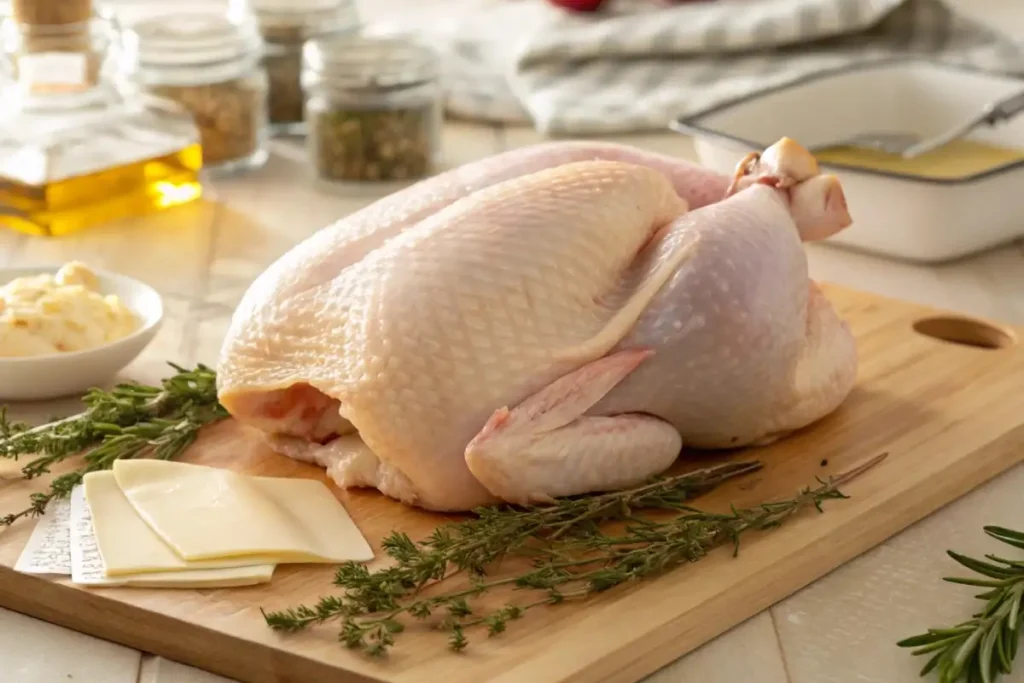
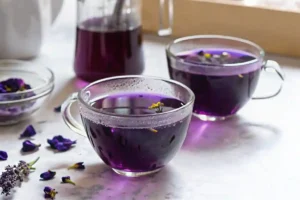
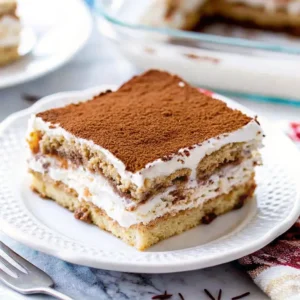
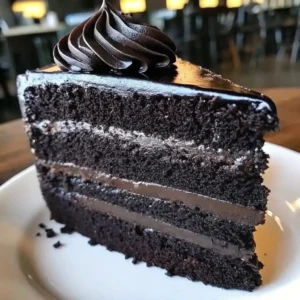
2 thoughts on “Should I Put Butter Under The Skin Of My Turkey? Game-Changing Culinary Secrets”